译林版九年级上册unit1教案全集
- 格式:doc
- 大小:95.00 KB
- 文档页数:11
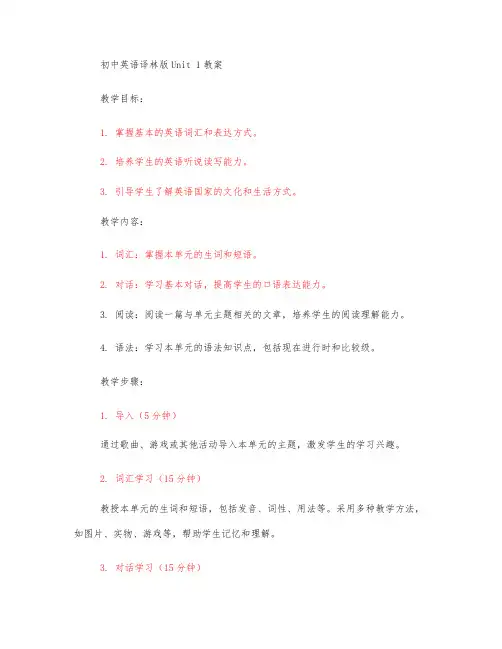
初中英语译林版Unit 1教案教学目标:1. 掌握基本的英语词汇和表达方式。
2. 培养学生的英语听说读写能力。
3. 引导学生了解英语国家的文化和生活方式。
教学内容:1. 词汇:掌握本单元的生词和短语。
2. 对话:学习基本对话,提高学生的口语表达能力。
3. 阅读:阅读一篇与单元主题相关的文章,培养学生的阅读理解能力。
4. 语法:学习本单元的语法知识点,包括现在进行时和比较级。
教学步骤:1. 导入(5分钟)通过歌曲、游戏或其他活动导入本单元的主题,激发学生的学习兴趣。
2. 词汇学习(15分钟)教授本单元的生词和短语,包括发音、词性、用法等。
采用多种教学方法,如图片、实物、游戏等,帮助学生记忆和理解。
3. 对话学习(15分钟)学习基本对话,包括问候、介绍、询问等日常用语。
通过角色扮演、小组讨论等方式,让学生在实际情境中运用所学对话。
4. 阅读理解(15分钟)阅读一篇与单元主题相关的文章,引导学生理解文章大意,回答相关问题。
培养学生的阅读理解能力和阅读速度。
5. 语法讲解(15分钟)讲解本单元的语法知识点,包括现在进行时和比较级。
通过例句和练习题,帮助学生理解和掌握语法规则。
6. 练习与巩固(10分钟)通过练习题、听力、口语等方式,巩固所学词汇、对话和语法知识。
及时纠正学生的错误,提高学生的学习效果。
7. 课堂小结(5分钟)对本节课所学内容进行总结,强调重点和难点。
布置课后作业,要求学生复习所学内容,预习下一单元内容。
教学评价:1. 通过课堂表现、作业完成情况、考试成绩等方式评价学生的学习效果。
2. 及时反馈学生的学习情况,鼓励学生积极参与课堂活动,提高学习自信心。
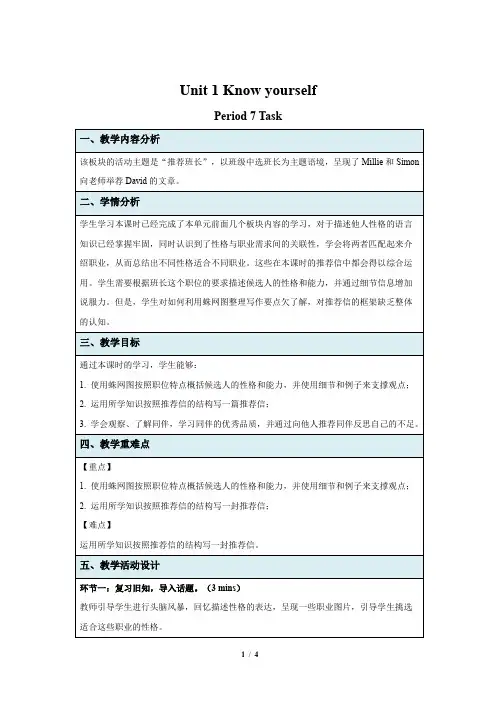
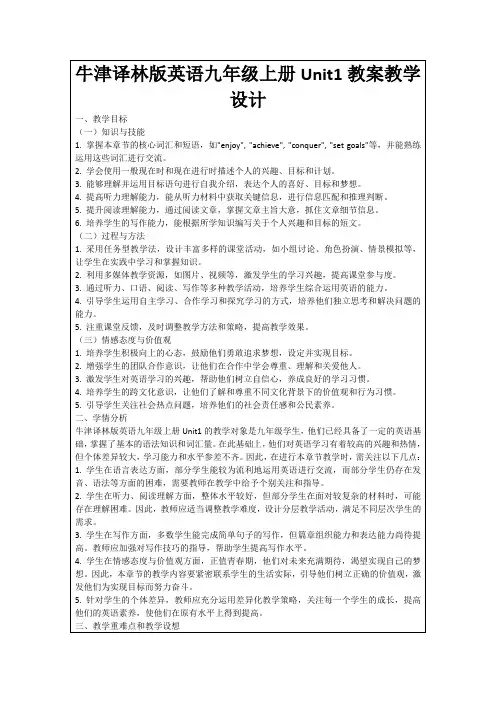
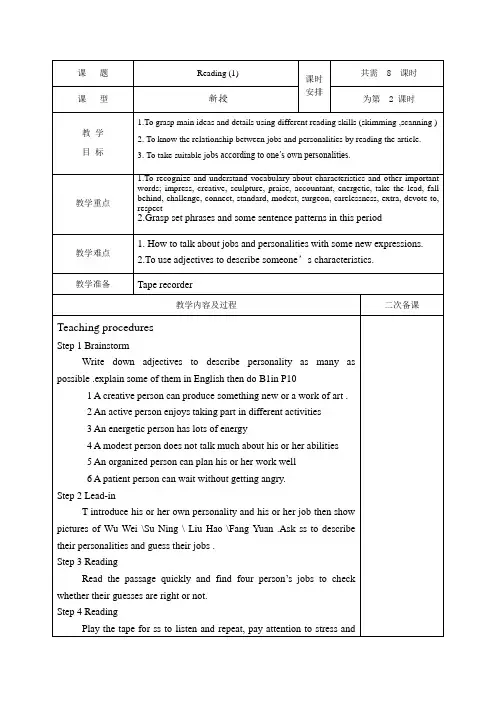
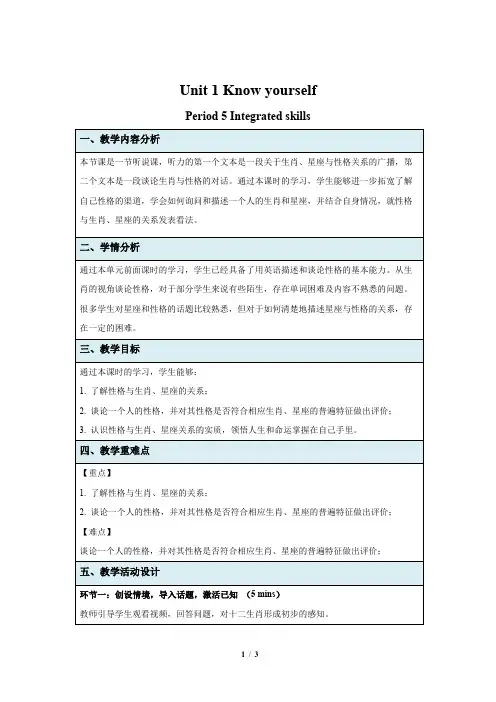
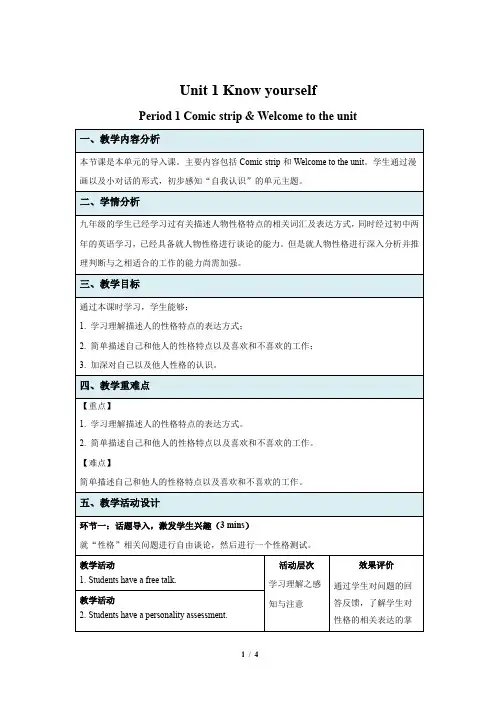
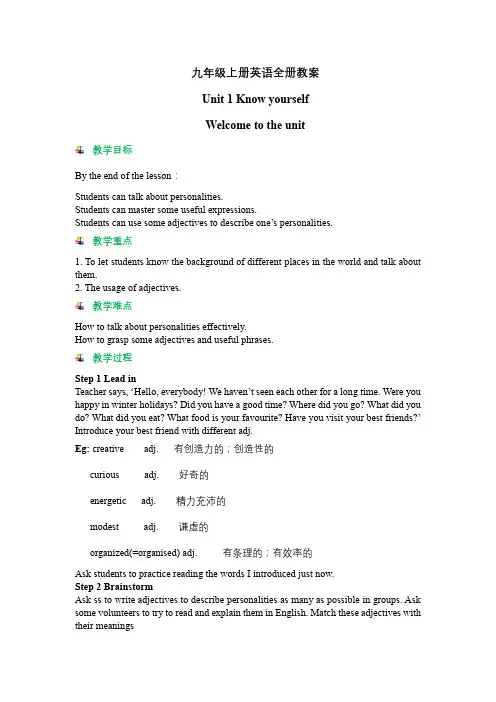
九年级上册英语全册教案Unit 1 Know yourselfWelcome to the unit教学目标By the end of the lesson:Students can talk about personalities.Students can master some useful expressions.Students can use some adjectives to describe one’s personalities.教学重点1. To let students know the background of different places in the world and talk about them.2. The usage of adjectives.教学难点How to talk about personalities effectively.How to grasp some adjectives and useful phrases.教学过程Step 1 Lead inTeacher says, ‘Hello, everybody! We haven’t seen each other for a long time. Were you happy in winter holidays? Did you have a good time? Where did you go? What did you do? What did you eat? What food is your favourite? Have you visit your best friends?’ Introduce your best friend with different adj.Eg: creative adj. 有创造力的;创造性的curious adj.好奇的energetic adj.精力充沛的modest adj.谦虚的organized(=organised) adj. 有条理的;有效率的Ask students to practice reading the words I introduced just now.Step 2 BrainstormAsk ss to write adjectives to describe personalities as many as possible in groups. Ask some volunteers to try to read and explain them in English. Match these adjectives with their meaningsOrganized -----keep…in good orders modest-----the opposite of show off Patient -------- without getting angry creative ----think of new ideas Curious ------- eager to know or learn energetic -----full of energyAsk ss to choose one adjective to describe themselvesStep 3 Presentation1. Teacher asks, do you still remember Hobo and Eddie? How are they this term? What are they talking about now? Let’s listen to the tape. (Play the tape for the Ss to listen to the dialogue between Hobo and Eddie.)2. Ask some questions about it:What makes generous people feel good?Is Eddie really generous?Why did Hobo eat up all the breakfast?Step 4 ExplanationExplain the important phrases and sentences in the dialogue.Step 5 Practice1. Work in pairs and drill the dialogue.2. Ask some Ss to act the dialogue out.Step 6 PresentationA. Some words are often used to describe people's personalities.Help Millie complete the following sentences with the words in the box.B. Millie and her classmates are talking about their own personalities and the kind of job they like or dislike. Work in groups and talk about yourselves.Use the conversation below as a model.C. Explain and Practice using the following phrases and sentences.keeps all her things in good order.shows offrepeat grammar rules for us.comes up withNeither my parents nor I think I can make a good accountant.It's terrible for me to work without speaking all day long.Step 7 Homework1. Recite the important sentences.2. Preview Reading.Unit 1 Know yourselfReading(Ⅰ)Teaching objectivesBy the end of the lesson, students should be able to:1. guess the meanings of the new words from the context;2. talk about jobs and personalities;3. identify the main idea of each paragraph in the passage by skimming;4. describe the four people’s jobs and personalities by detailed reading;5.improve their reading abilities.Important pointsHow to talk about jobs and personalities with some new expressions.Teaching contents1. New words and phrases:born, impress, sculpture, praise, sales department, general,race, either or, lead, take the lead, fall behind, challenge,chief, high-speed, connect, connect to/with, miss, as goodas, attention, pay attention to, standard, pioneer, surgeon,carelessness, extra, devote, respect, suitable, partner2. New structures:Life is like a race. You either take the lead or fall behind.A miss is as good as a mile.As a doctor, you can’t be too careful.III. Focus of the lesson and predicted area of difficulty1. To read the passage in different ways;2. To describe four people’s jobs and personalities by detailed reading.IV.Teaching proceduresStep 1 Warming-upFree talkT: Today, we’ll meet some outstanding people. They like their jobs very much. Now show me your ideas, what kind of person are they?Step 2 Pre-reading1. Watch a videoT: Who is this man? Let’s watch a video first.T: You know him very well. He is the pioneer of Alibaba. He is devoting most of his time to it.He says, “If not now, when? If not me, who?” Any time he is ready to take onnew challenges. He always works to high standards. Now he is one of the richest in China. So people often say he is a born businessman.2. PredictionT: Look at these pictures from Sunshine Town. They are also outstanding in their fields. Would you please guess what their jobs are?Step 3 While-reading1. SkimmingT: Now please look through the text quickly and check if you have made the rightprediction, also try to find what they think of their jobs.T: Yes, Wu Wei is an artist, Su Ning is a manager, Liu Tao is an engineer, and Fang Yuan is a doctor. What do they think of their jobs?T: Yeah, they are happy with their jobs. How can you get the information quickly? T: Great! Pay attention to the title and the pictures while reading.2. ScanningPassage 1:(1) Read and answerT: Now let’s read Passage 1 more carefully and answer two questions:●What does Wu Wei’s best friend think of him?●What has won Wu Wei high praise from the art community?T: Yes, his best friend said, “He is a born artist. He’s quiet and doesn’t like to talk much, but his work shouts.” And his sculptures for Sunshine Town Square have won high praise from the art community.(2) Read and guessT: Good job! Let’s do some guessing work. What does “his work shouts” mean here?T: Yes, that is to say his work is wonderful. Then what about “praise”? What does it mean?T: Excellent! How can we guess the meaning of new words?T: I agree. Circle some key words before and after the new word or the sentence.It’s possible to find its meaning.(3) Read and thinkT: Wu Wei said, “I want to share the best art with people, so I’m always searching for something better or different. This in itself is great fun.” What can you infer from it?T: I love all your ideas. He is so creative and of course he is happy with his job. Passage 2:Read and finishT: Find out some information about Su Ning’s past and present.five years ago•was an __________•only worked with ______•made me _______(accountant, numbers, unhappy) now•is a general manager•is active and _________•love working with ________•is ready to take on ________ any time (energetic, people, challenges)Passage 3:Read and practicePassage 4:An interview between groupsT: Read through Passage 4 and do an interview with Fang Yuan in pairs. Try to ask more questions and give detailed answers. The team which gets the most stars will be the winner.3.Further reading(1) ThinkingT: What do the sentences mean? Choose the right Chinese meaning, and try to find out some supporting sentences.●Life is like a race. You either take the lead or fall behind.● A miss is as good as a mile.●As a doctor, you can’t be too careful.(2) Listen and circleT: Now I’ve collected many words about their personalities. Please circle them in your books and try to match the words with the four persons.T: OK, Wu Wei is quiet and creative. Su Ning is active and energetic. Liu Tao is serious, organized and modest. Fang Yuan is kind, patient and careful. Different people have different personalities, and they also have different jobs. Are the jobs suitable for them? Why? You may use the sentences in the text to support your ideas.Step 4 Post-reading1.Listen and adviseT: The four persons here are all happy with their present jobs, and the jobs are suitable for them. Now let’s listen to a short conversation from Cindy, Stone and Tiantian.Write down their future jobs.T: Stone would like to be an engineer, Cindy hopes to be an artist, and Tiantian prefers to be a manager. Would you please give them some advice so that their personalities can match the job requirements.2.Share and reportT: It’s your turn to talk about yourselves. Think about what job you want to do in the future and if your personality matches the job requirements. You can share your ideas in groups, and then speak in front of the class.T: I hope you all can have a bright future. In your daily life, you should form good personalities to get ready for the future job. I believe finally you can be the one that you want to be.Homework1. Search more articles about people who are outstanding in their fields and try to make notes.2. Finish your own article about jobs and personalities and read it to your friend.Unit 1 Know yourselfReading (Ⅰ)Teaching objectivesBy the end of the lesson, students should be able to:1. describe people’s jobs and personalities by using what they learn in this period;2. talk about what the four people do and their personalities;3. have a better sense of working hard and being outstanding;4. understand vocabulary about characteristics and other important words.Important points1.To recognize and understand the important phrases;2. To use the new words and phrases to describe people’s personalities and jobs.Teaching contents1. New words and phrases: born, impress, sculpture, praise, sales department, general,race, either or, lead, take the lead, fall behind, challenge,chief, high-speed, connect, connect to/with, miss, as goodas, attention, pay attention to, standard, pioneer, surgeon,carelessness, extra, devote, respect, suitable, partner2. New structures: Life is like a race. You either take the lead or fall behind.As a doctor, you can’t be too careful.Carelessness will be a disaster not only to ourselves but also to patients.Teaching proceduresStep 1 Lead-inT: Guess who he is. He is the great Greek philosopher—Socrates and he once said, “Know yourself, and then you can understand life.”Step 2 ReviewingT: Knowing yourself is very important. Do the four outstanding people know themselves very well? Now you’ll be divided into four groups: Su Ning Group, Wu Wei Group, Liu Hao Group and Fang Yuan Group. Su Ning and Wu Wei Groups will discuss who is suitable for the general manager of a big company. Liu Hao and Fang Yuan Groups will discuss whether you are suitable for your jobs. Give your reasons. Step 3 DiscussionT: What’s your favourite saying? Why?Step 4 Language pointsPresent and practice the important words and expressions mentioned in the discussion.1. Life is like a race. You either take the lead or fall behind.T: Look at the picture of Liu Xiang.Liu Xiang is taking the lead in the race.The other top players are falling behind in the race.T: You know the story of the hare and tortoise. Can you say something about it? S: The hare is taking the lead. The tortoise is falling behind.T: In this race, either the hare or tortoise will win.2.either ... or ...T: If you’re planning a day out, what will you choose to do? Use “either … or …”to make a conversation3. It’s necessaryto pay attention to every detail.T: When you go on an outing, what should you pay attention to?S: …T: pay attention to sth. 注意某事pay attention to doing sth. 注意做某事Try to complete the sentences:Pay attention to protecting the environment.Successful businessmen always pay attention to details.4. I’m ready to take on new challenges any time.Present new structures “take on new challenges”, “connect … to …” by talking about Ma Yun.T: Ma Yun and Bill Gates are both successful businessmen. Ma Yun likes taking on new challenges. He owns Alibaba, Taobao, China Yahoo, etc. He has connect ed the Internet to people’s life.It’s your turn to talk about Bill Gates.5. He has impress ed the whole country with his work.T: Ma Yun and Bill Gates has impressed us with their creative ideas. Have youheard about a disabled young girl called Liao Zhi, whose legs were hurt during an earthquake? What about Nick Vujicic, a famous speaker with no arms andlegs?(1) Liao Zhi, the young disabled dancer, has impressed the country with herwonderful spirit and dancing skills.(2)Nick Vujicic has no arms or legs, but he has impressed the whole world with his speeches.Practice (Open task):Watch a video about Nick Vujicic and Practice:Nick ________________ me with ___________________.6. Carelessness will be a disaster not only to ourselves but also to patientsT: Nick Vujicic can not only choose how to live but also face problems bravely.Now look at these two pictures. Use “not only … but also” to make one sentence. T: So Not only my husband but also my daughter likes him very much. Some tips for you.Careless is a humorous film. Not only children but also adults like it.7.carelessnessT: Learn to use “care”, “careful”, “careless”, “carelessly” and “carelessness”. After that, try to make a summary about them.●Take _______. The bus is coming.●Be ________ with fire. It can be dangerous.●The less __________, the fewer mistakes.●Pay attention to your safety. Don’t drive ___________.●_________________ will lead to accidents.8. As a doctor, you can’t be too careful.T: As a driver, don’t drive carelessly. Carelessness will lead to accidents. Thatmeans you can’t be too careful when driving.T: Would you please talk about your ideas? As a student/teacher/…, you can’t be too _________. In a word, one can’t be too modest.Step 5 Other words and phrasesT: Read the four passages again. Underline all the new words and phrases and see if you understand them.Step 6 Practice1. Use some of the new phrases to complete the sentences2. DescriptionChoose at least four phrases to talk about your hero.(1) a born …(2) win high praise from(3) either … or …/not only … but also …(4) take the lead/fall behind(5) be ready to/ be willing to …(6) take on new challenges(7) connect … to …(8) pay attention to …(9) work to high standardsStep 7 Myfavourite sayingT: The American educator, Samuel Bubler once said, “Every man’s work, whether it be literature or music or pictures or architecture or anything else, is always a portrait of himself.” So love what we do.HomeworkWrite about your hero’s personality and job, and share it in your groups.Unit 1 Know yourselfGrammarTeaching goalsKnowledge and skills:To master the usage of conjunctions like and but or and so.Process and method:Listening,speaking,reading.Emotion and attitude:Use conjunctions to join ideas together.Important and difficult points1. Use conjunctions to join ideas together.2. Use conjunctions to join ideas together.Teaching proceduresA Using and, but, or and soStep 1 Lead inFree talkT: Today, we’ll learn Grammar of Unit 1. We’ve met four outstanding persons. Do you remember them? (Show the pictures of the characters we’ve learned.)S: They are Wu Wei, Su Ning, Liu Tao and Fang Yuan.T: Among them, I admire Wu Wei the most because I wanted to be an artist when I was young.Step 2 Presentation1. BrainstormingT: How much do you know about Wu Wei?workshobby personalitysayingWu WeiS: He is quiet and doesn’t like to talk much.S: He impressed the whole country with his creative work.S: I want to share the best art with people, so I’m always searching for something better or different.T: Do you know something about his hobby? Let’s listen together.(Wu Wei: I like doing something quiet like fishing and watching TV. I don’t like singing or dancing)S: He likes fishing and watching TV. He doesn’t like singing or dancing.Step 3 Practice1. Show the picture of Wu WeiT: Wu Wei likes reading and watching TV. Guess what TV programmes he likes watching.S: …(Play the theme songs of two TV programmes.)T: He likes watching “the V oice of China” and “Dad, where are we going?” like you and me. Let’s talk about “the V oice of China” first.2. Show some pictures of the programmesAsk the students to describe the pictures, and join the sentences together with and, but, or or so.(1) We can watch the programmes on TV. We can watch the programmes on the Internet.We can watch the programmes on TV or on the Internet.(2) The rules of the programmes are special. Many people are interested in it.The rules of the programmes are special so many people are interested in it.(3) The coaches sit with their backs to the singers. They listen carefully.The coaches sit with their backs to the singers, but they listen carefully.(4) The girl sang very well. Four coaches all turned their chairs.The girl sang very well, so four coaches all turned their chairs.(5) She didn’t choose Yang Kun. She didn’t choose Qi Qin. She chose Na Ying.She didn’t choose Yang Kun or Qi Qin.She thought twice, and she chose Na Ying finally. (think twice: 三思,再三考虑)Step 4 Production1. DiscussionT: We often use and, but, or and so to join ideas together. Let’s have a discussion: When we join ideas together, how should we use these conjunctions?and join different ideasbut introduce another possibility/join two or more ideas (in negative sentences)so join similar ideasor express the results of something2. Finish the exercises on Page 123. Game timeT: You are so great. Now, let’s play a game to see which group will be the winner.Here are the rules: You are divided into 4 groups. Try to make sentences with and, but, or and so. If the first student in Group1 makes a sentence correctly, thenhe’ll have the chance to ask the first one in Group 2 to make a sentence with any word of the four … If you can’t make a sentence in 5 seconds, your group will lose the game.B Using both … and …, not only … but (also) …, either … or … and neither … nor …Step 1 Lead inFree talkT: Just now, we talked about “the V oice of China”. You’ve done a good job. What other programme does Wu Wei like?S: It’s “Dad, where are we going?”T: This programme is popular this year. I also like watching it.Step 2 Presentation1. Talk about “Dad, where are we going?”(1) The show is popular in China. The show is popular in other countries.The show is popular not only in China but also in other countries.The show is popular not only in China but in other countries.T: Who take part in the show?(2) Dads take part in the show. Their kids take part in the show.Not only Dads but also their kids take part in the show.Both dads and their kids take part in the show.(3) Feynman is five years old. Joe is five years old too.Not only Feynman but also Joe is five years old.Both Feynman and Joe are five years old.(4) Joe isn’t happy. Grace isn’t happy.Neither Joe nor Grace is happy.(5) The boy is so lovely. We call him Yang Yangyang. In fact, his name is Yang Wenchang.We can call him either Yang Yangyang or Yang Wenchang.(6) The two boys are wrestling. Either Joe or Feynman does better in wrestling. 2. DiscussionPlease read all these sentences by yourselves. Then discuss two questions: How should we use these conjunctions? How should we use the verb form?We use _________ to emphasize that something is true not just of one person, thing or situation but of another too.We use __________ to add another fact to something you have mentioned.We use __________ to mean one or the other, this or that, he or she, etc.We use __________ to mean not this one and the other, not this and not that, not he and not she etc.Step 3 Practice1. Finish B1 on Page 142. Finish B2 on Page 143. A competitionAmy made an interview in her class. Look at the form carefully, and try to get the information. Then, let’s have a competition in groups. Try to make as manysentences as possible with conjunctions we have learned. One of your group members should write them down. If your group gets the most sentences, you are the winner. For example: Nancy is both creative and curious.Step 4 ProductionT: All of you have done a good job! Let’s enjoy a poem together to relax.T: We all know that this poem is about my dream. Now it’s your turn to write about your dream or your school life. You can use this poem as a model.T: When we write, we can use conjunctions if necessary. Keep trying, and I think you can write something beautiful one day!V. Homework1. Interview two of your classmates about their personalities and future jobs;2. Write a short report about the interview. Try to use conjunctions.教学反思Unit 1 Know yourselfIntegrated skillsTeaching goalsKnowledge and skills:To get specific information from a listening material.Process and method:To talk about personalities.Emotion and attitude:To talk about animal signs.Important and difficult points1.To listen to the tape and get information about the radio programme.2. To learn about Chinese animal signs and personalities.Teaching proceduresStep1 Lead in1. Show the animal signs and English names.Rat horse ox sheep tiger monkey rabbit rooster dragon dog snake pig2. What do you think of monkeys? They are clever.3. New words lunar calendar animal sign represent appear fixed order cycle powerful lively practical loyalStep 2Listening1. Read A1, try to finish A2 with as much information as possible.2. Listen to the tape without writing.3. New words divide divide ...into... Shape4. Finish A35. Read A3.Speak up:We can read about them for fun.Step3 Presentation1. Is it true that people born under the same animal sign or star sign may have similar personalities? It may be true,but we shouldn’t believe in them. Let’s listen to a conversation between Millie and her neighbour Joe. Then answer these questions:1) What is Joe’s animal sign?2) What are people born in the year of the Tiger like?3) Whose animal sign is the sheep?4) What is Julie like?5) What does Millie think of the relationship between signs and personalities?2. Revise born brave in some ways that’s not the caseGentle believe inStep 4 Activities1. Practice in pairs.It is said that... It says that...I’m not sure... I agree/ disagreeI (don’t) think... That’s not the case.What about?2. Show their conversation.Step 5 Homework.Recite speak up.Blackboard Designappear in a fixed order every 12 yearsin all decide your personalitythe year of the Rabbit divide ... intoIt is you who shape your life and your future.People born under the same animal sign课堂检测动词填空1.You are the most suitable _______________(take) this job.2.—Where’s your brother?—He _________(do) an operation.3.What a creative artist! He ______________(impress) the whole country with the sculpture.4.We can’t afford ____________(fall) behind our classmate.5.You can go and play tennis only when your report ____________(finish).6.When I went to visit him yesterday, he ____________(read) a magazine about personalities.Homework1. Read A3 on page 16 and try to remember more information;2. Practice talking about animals and personalities with your partner;3. Write down your own ideas about what decides your personality.Teaching reflectionUnit 1 Know yourselfStudy skillsTeaching objectsKnowledge and skills:To get specific information of skimming.Process and method:How to skim.Emotion and attitude:To talk about skimming.Important and difficult points1. Learn to skim an article.2. Learn to skim an article.Teaching contentStep 1 Lead in1. Free talkT: Boys and girls, can you tell me what you often do when you are free?S: …T: We have a lot of things to do in our spare time. Do you want to know about my hobby? You can find it by finishing the saying: ______ are the stepping stones of human progress.S:Books.T: Yes. Books are the stepping stones of human progress. I spend much time reading books every day because I think reading brings us everything. Do you like reading books?S: Yes, of course.T: I’d like to tell you a piece of good news. Our school will set up a reading club. If you want to join the club, please answer three questions about the reading skills.Let’s do it together.Step 2 Presentation1. Understand the meaning of the skimming(1) T: Now, the first question is “What is skimming?” If you don’t know the answer,it doesn’t matter. I’ll help you.(2) Show the picture of “skim stones”, and talk about it.T: Look at the picture. What’s the young man doing?T: He is playing a game called “skim stones”. People try to throw a little stone onto the surface of the water, and make it float on the surface as far as possible before it sinks. And here “skim” means “漂过” or “略过”.(3) Make a choiceT: So, what does skimming mean while reading? Of the two idioms, which is more similar to “skimming”, “字斟句酌” or “浮光掠影”?T: I agree with you. “浮光掠影” is closer to skimming. What does “浮光掠影”mean in Chinese?T: So, when skimming, do we read fast or slowly? Do we expect to get the main idea or specific information?S: …T: Skimming means reading the text quickly to get the main idea. You can understand the word in this way: “s” stands for the speed of the reading;“m”means the main idea. I hope it will help you understand “skim” better.2. Learn how to skim when readingT: Since you have understood the meaning of “skimming”, let’s come to the second question: How to skim when reading? That is to say, how can we read fast and get the main idea at the same time?(1) Show the reading process of four people. Ask students to tell if they are skimming.(2) Discussion: In Which part of the text can we find the main idea quickly?(3) Draw the conclusion: When skimming, read the title, the main headings, the firstand last paragraphs, and the first sentence of each paragraph.3. Find the main idea of the article by skimmingT: You’ve done a good job. The last task is to find the main idea of an article by skimming in one minute. I’ll give you three questions to help you:(1) What is the article about?(2) Is it true that some aspects of your personality are formed by nature?(3) What can change your personality?T: As you have answered three questions correctly, you have the chance to be the member the reading club.Step 3 Practice1. A competitionT: Now, let’s have a competition. We will vote for the best readers in our class. Who can find the main ideas of the following articles in the shortest time will be the best readers in our class.2. T: We all know that reading is a good habit to all of us. Let’s share a saying aboutreading: Reading ten thousand books is like travelling ten thousand miles. In Chinese, we say “读万卷书,行万里路”. Actually, we have different ways of reading. Sometimes, skimming is useful. Sometimes, we need to get the specific information. Join the reading club, and more reading activities are waiting for you!课堂检测一、根据句意和所给汉英释义写出单词1. He ________________(分成)a cake into pieces and gave them out to his children.2. Jack enjoyed reading all kinds of books. These books ______________(塑造)his ideals about the world.3. Nora’s birthday is not in this year’s ______________(日历). Do you know why?4. It was nearly half an hour before the bus __________________(start to be seen) at the street corner.5. Linda is a _____________________(full of energy,very active)girl. We all like her.6. Our classes begin and finish at ______________(not changing) times.Homework1. Skim one or two articles to get main idea;2. Search the Internet to know more about reading skills.教学反思Unit 1 Know yourselfTask。
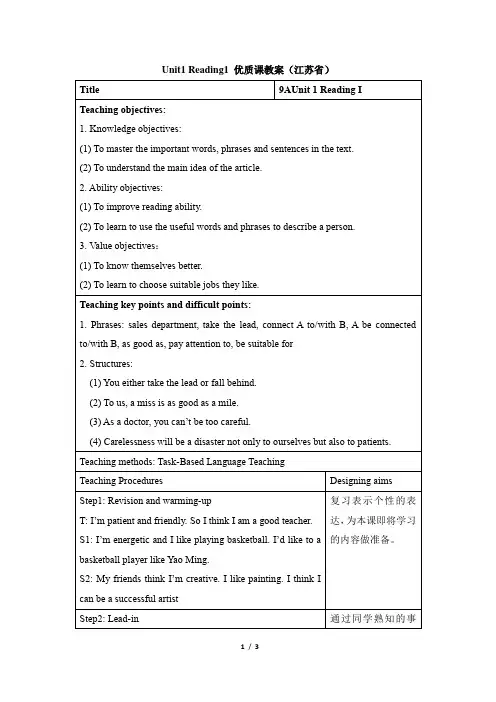
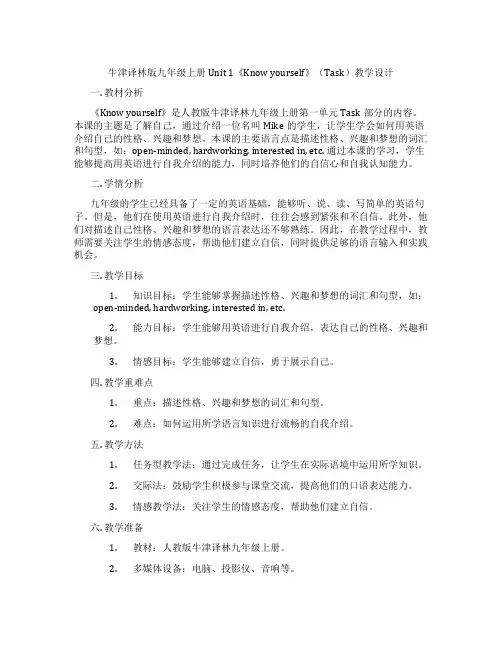
牛津译林版九年级上册Unit 1《Know yourself》(Task)教学设计一. 教材分析《Know yourself》是人教版牛津译林九年级上册第一单元Task部分的内容。
本课的主题是了解自己,通过介绍一位名叫Mike的学生,让学生学会如何用英语介绍自己的性格、兴趣和梦想。
本课的主要语言点是描述性格、兴趣和梦想的词汇和句型,如:open-minded, hardworking, interested in, etc. 通过本课的学习,学生能够提高用英语进行自我介绍的能力,同时培养他们的自信心和自我认知能力。
二. 学情分析九年级的学生已经具备了一定的英语基础,能够听、说、读、写简单的英语句子。
但是,他们在使用英语进行自我介绍时,往往会感到紧张和不自信。
此外,他们对描述自己性格、兴趣和梦想的语言表达还不够熟练。
因此,在教学过程中,教师需要关注学生的情感态度,帮助他们建立自信,同时提供足够的语言输入和实践机会。
三. 教学目标1.知识目标:学生能够掌握描述性格、兴趣和梦想的词汇和句型,如:open-minded, hardworking, interested in, etc.2.能力目标:学生能够用英语进行自我介绍,表达自己的性格、兴趣和梦想。
3.情感目标:学生能够建立自信,勇于展示自己。
四. 教学重难点1.重点:描述性格、兴趣和梦想的词汇和句型。
2.难点:如何运用所学语言知识进行流畅的自我介绍。
五. 教学方法1.任务型教学法:通过完成任务,让学生在实际语境中运用所学知识。
2.交际法:鼓励学生积极参与课堂交流,提高他们的口语表达能力。
3.情感教学法:关注学生的情感态度,帮助他们建立自信。
六. 教学准备1.教材:人教版牛津译林九年级上册。
2.多媒体设备:电脑、投影仪、音响等。
3.教学课件:根据教学内容设计的课件。
4.作业素材:相关阅读材料和练习题。
七. 教学过程1.导入(5分钟)利用多媒体展示一位学生的照片,让学生猜测这位学生的性格、兴趣和梦想。

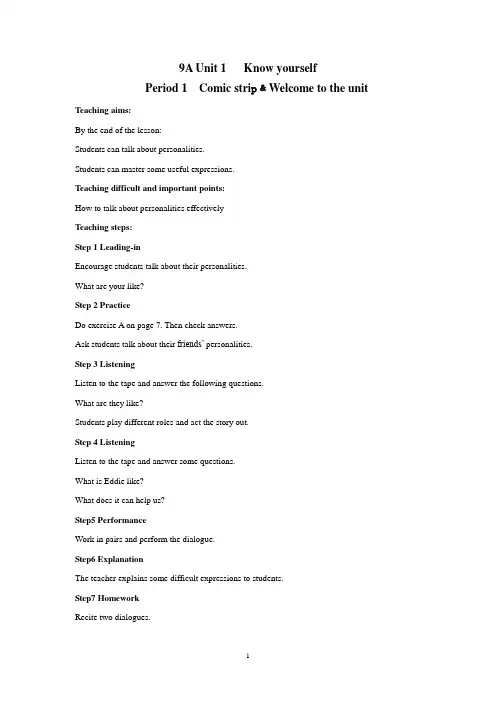
9A Unit 1 Know yourselfPeriod 1 Comic stri p﹠Welcome to the unit Teaching aims:By the end of the lesson:Students can talk about personalities.Students can master some useful expressions.Teaching difficult and important points:How to talk about personalities effectivelyTeaching steps:Step 1 Leading-inEncourage students talk about their personalities.What are your like?Step 2 PracticeDo exercise A on page 7. Then check answers.Ask students talk about their friends’ personalities.Step 3 ListeningListen to the tape and answer the following questions.What are they like?Students play different roles and act the story out.Step 4 ListeningListen to the tape and answer some questions.What is Eddie like?What does it can help us?Step5 PerformanceWork in pairs and perform the dialogue.Step6 ExplanationThe teacher explains some difficult expressions to students.Step7 HomeworkRecite two dialogues.Remember some new words.【教后反思】【课堂检测】I 根据句意及括号内所给汉语提示写出单词。
牛津译林版九年级上册Unit 1《Know yourself》(Grammar)教学设计一. 教材分析牛津译林版九年级上册Unit 1《Know yourself》主要介绍了一般现在时态的用法。
本节课通过三个部分的学习,让学生掌握一般现在时态的构成(主语+动词原形)、肯定句和否定句的结构,以及一般现在时态的常用句型。
教材内容贴近学生生活,易于激发学生的学习兴趣。
二. 学情分析九年级的学生已经掌握了基本的英语语法知识,对一般现在时态有一定的了解。
但部分学生对一般现在时态的运用还不够熟练,特别是在实际口语交流中。
因此,在教学过程中,需要关注学生的个体差异,有针对性地进行教学。
三. 教学目标1.知识目标:学生能够掌握一般现在时态的构成、肯定句和否定句的结构,以及一般现在时态的常用句型。
2.能力目标:学生能够在实际语境中正确运用一般现在时态,进行简单的交流。
3.情感目标:通过本节课的学习,学生能够增强自信心,更好地了解自己。
四. 教学重难点1.教学重点:一般现在时态的构成、肯定句和否定句的结构,以及一般现在时态的常用句型。
2.教学难点:一般现在时态在实际语境中的运用。
五. 教学方法1.任务型教学法:通过设置各种真实的任务,让学生在完成任务的过程中运用所学知识。
2.情境教学法:创设各种生活情境,让学生在实际语境中学习一般现在时态。
3.小组合作学习:鼓励学生分组讨论,互相交流,提高学生的参与度和合作能力。
六. 教学准备1.教学课件:制作课件,展示一般现在时态的用法。
2.练习题:准备一些练习题,用于巩固所学知识。
3.教学道具:准备一些图片、卡片等道具,辅助教学。
七. 教学过程1.导入(5分钟)利用图片、卡片等道具,引导学生谈论自己的兴趣爱好、家庭成员等,引出一般现在时态的概念。
2.呈现(10分钟)通过课件展示一般现在时态的构成(主语+动词原形)、肯定句和否定句的结构,以及一般现在时态的常用句型。
让学生进行观察、思考,理解一般现在时态的用法。
牛津译林版英语九年级上册 Unit 1 《Know yourself.》教学设计3一. 教材分析《Know yourself》是牛津译林版英语九年级上册Unit 1的一篇课文,主题是了解自己,认识自己。
本课主要介绍了一种自我认知的方法——性格测试。
通过阅读课文,学生可以了解性格测试的基本概念、测试过程以及如何根据测试结果来认识自己。
教材内容丰富,贴近学生生活,激发学生对自我认知的兴趣。
二. 学情分析九年级的学生已经具备了一定的英语基础,能够理解和运用一些基本的英语句型和词汇。
但部分学生对抽象的概念如性格测试的理解可能存在困难,因此需要在教学中进行适当的引导和解释。
此外,学生可能对自我认知这一主题比较感兴趣,但同时也可能存在一定的心理压力。
三. 教学目标1.知识目标:学生能够掌握与性格测试相关的词汇和句型,如“personality test”、“self-awareness”等。
2.能力目标:学生能够阅读并理解关于性格测试的英语文章,运用所学词汇和句型进行简单的交流。
3.情感目标:学生能够通过课文学习,认识到了解自己的重要性,激发自我认知的兴趣。
四. 教学重难点1.重点:性格测试相关词汇和句型的学习,以及课文的阅读理解。
2.难点:对性格测试概念的理解,以及如何在实际生活中运用这一概念。
五. 教学方法1.任务型教学法:通过设置各种任务,让学生在实践中学习和运用英语。
2.情境教学法:创设生活情境,让学生在真实的环境中学习英语。
3.合作学习法:鼓励学生小组讨论,共同完成学习任务。
六. 教学准备1.课件:制作与课文内容相关的课件,帮助学生更好地理解课文。
2.学案:为学生提供学习指导,包括词汇表、课文翻译等。
3.性格测试题:为学生提供一份简单的性格测试题,用于课后实践。
七. 教学过程1.导入(5分钟)利用课件展示一些关于性格测试的图片,引导学生谈论自己对性格测试的了解和经历,激发学生的兴趣。
2.呈现(10分钟)为学生呈现课文,让学生初步阅读并了解课文大意。
9A Unit 1 Know yourselfPeriod 1 Comic stri p﹠Welcome to the unit Teaching aims:By the end of the lesson:Students can talk about personalities.Students can master some useful expressions.Teaching difficult and important points:How to talk about personalities effectivelyTeaching steps:Step 1 Leading-inEncourage students talk about their personalities.What are your like?Step 2 PracticeDo exercise A on page 7. Then check answers.Ask students talk about their friends’ personalities.Step 3 ListeningListen to the tape and answer the following questions.What are they like?Students play different roles and act the story out.Step 4 ListeningListen to the tape and answer some questions.What is Eddie like?What does it can help us?Step5 PerformanceWork in pairs and perform the dialogue.Step6 ExplanationThe teacher explains some difficult expressions to students.Step7 HomeworkRecite two dialogues.Remember some new words.【教后反思】【课堂检测】I 根据句意及括号内所给汉语提示写出单词。
1.Tom is ___________ (精力充沛的) enough to play basketball for hours every day.2.Linda does best in English in our class. But she is very ________ (谦虚的).3.__________ (两者都不) of the twins is interested in playing the piano.4.My new neighbour Elsa is ___________ (好奇的) about everything.5.As a writer, you should be ________ (有创造力的).II 用括号内所给单词的适当形式填空lie is very __________ (organize). She can plan everything well by herself.2.Andy, could you express ________ (you) well?3.Amy hurried to leave home without ________ (say) goodbye to anyone.4.His generous personality makes him feel good ________ (share) things with others.5.Amy often has ________ (create) ideas. What job is suitable for her?III单项选择1.Scientists are trying their best to ________ ways to treat the terrible disease called H7N9.e up withB. look forward toC. talk aboutD. give up2.Let’s go to Kunming for vacation. It’s ______ too hot ______ too cold there.A.either; orB. neither; norC. both; andD. not only; but also3.---- Can you see the notice there? ---- Yes, it ________ “No Smoking Here”.A.saysB. writesC. readsD. Speaks4.---- The summer holiday is on the way. We’ll have more freedom.---- ________. But we should learn to manage ourselves.A.I’d love toB. I agree with youC. I’m afraid I won’tD. I’d like5.My physics teacher is ________ to spend much time ________ things to us.A.patient enough; explainB. enough patient; explainingC. patient enough; explainingD. enough patient; explain6.---- Who is the most modest boy in your class?---- Daniel. He never ________ in public.A.gets offB. takes offC. shows offD. turns off7.---- ________ you ________ my cake?----Yes, I’ve _______ finished it.A.Have; eaten out; justB. Have; eaten up; yetC. Did; eat up; alreadyD. Did; eat out; yet8.---- How does your mother like your presents for Mother;s Day?---- Well, _______ this sweater ______ that one is fit for her. They’re too big.A.both; andB. either; orC. neither; norD. not only; but alsoIV. 根据汉语完成句子1.Here is ___________________________________(一篇关于性格的有趣的文章).2.Suzy is well organized to ____________________________.(所有物品摆放有序).3. Mr Wu is _______________________________(足够耐心给我们重复语法规则).4. 父母和我都不认为我能做一名好的会计。
_________________________________________________________________5. 对我来说整天工作不说话是可怕的。
_________________________________________________________9A Unit 1 Know yourselfPeriod 2 Reading 1Teaching aims:By the end of the lesson:Students can improve their reading abilities.Students can talk about jobs and personalities.Teaching difficult and important points:How to talk about jobs and personalities with some new expressions.Teaching steps:Step 1 Leading-inWhat jobs do you know? How about your parents?Are they happy with their jobs?Step 2 SkimmingHow many people does the passage introduce?What about their jobs?Step 3 While-reading1. ScanningScan the passage and finish exercise B1.2. Careful-readingRead the text carefully and finish exercise B2.Step 4 Post-readingListen to the tape and read the text loudly. And finish exercise B3.Step5 ActivitiesWrite a short description of your personalities.Work in pairs and talk about each others’ jobs and personalities.Step6 HomeworkDo exercises and read the text after the tape.【教后反思】【课堂检测】一、根据汉语填入词的适当形式。
1.Wu Wei’s best friend said,“He is a _____________(天生的)artist”.2.Wu Wei,the young artist,has _______________(给…留下印象)the whole country with his create work.3.His ______________(雕塑,雕像)for Sunshine Town Square have won high __________(赞扬,表扬)from the art community.4.Liu Hao is the _______(主要的,旨要的)engineer of the high-speed railway ____________(连接)Sunshine Town to Tianjing.5.Fang Yuan,head of Sunshine Hospital and a pioneer heart_____________(外科大夫).6.Su Ning is ready to take on new ______________(挑战)any time.7.Liu Hao always works to high _____________(标准),but he’s modest and easy to work with.8.Su Ning started to work for the _______________________(销售部)in a big company five year ago.9.Fang Yuan is always willing to work ____________ (额外的;附加的)hours.10.She has ___________(把…贡献,把…专用于)most of her time to her work.二、用所给单词的正确形式填空。